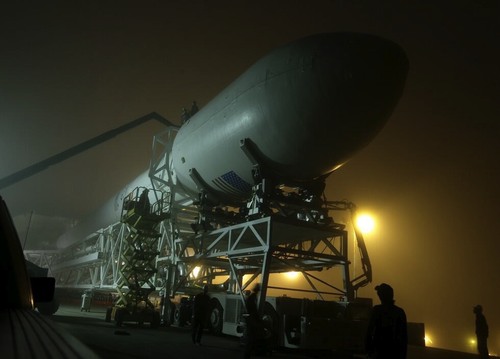
The first SpaceX Falcon 9 v1.1 rolling out to the launch pad at Vandenberg Air Force Base in California earlier this week. Photo tweeted by Elon Musk.
After months of waiting, the first launch of the upgraded version of the Falcon 9, called the Falcon 9 v1.1, appears to be imminent. On Tuesday SpaceX rolled the rocket out to its launch pad at Vandenberg Air Force Base in California, with plans to conduct a static fire of the rocket’s first stage engines on the pad before launch. The rollout was captured in a tweet by Elon Musk, including the photo above.
He also pointed to an article by Space News last week where he emphasizes the risks associated with what is, in many respects, a new launch vehicle, with upgraded engines and a stretched first stage. “We’re being, as usual, extremely paranoid about the launch and trying to do everything we possibly can to improve the probability of success, but this is a new version of Falcon 9,” he told Space News. The launch is also the first Falcon 9 mission to use a payload fairing (the previous flew Dragon spacecraft or test articles without a fairing) and also the first from Vandenberg.
“This is awfully exciting for us. It’s a bit of a nail-biter,” said Garrett Reisman, a former astronaut who is project manager for SpaceX’s commercial crew effort, during a panel session at the AIAA Space 2013 conference in San Diego Thursday afternoon. “We’re trying a lot of things for the first time. We’re just going to rip that band-aid off and give it a shot.”
The launch will also test potential reusability of the Falcon 9 first stage by restarting an engine after stage separation to slow the stage’s descent into the ocean. Musk told Space News that he gave the test “maybe a 10 percent chance of success” because of various uncertainties, including whether a landing radar on the stage can detect the ocean surface accurately. Reisman, at the conference agreed. “It’s something that I think, frankly, has a high probability of not being successful, but we’re going to give it a shot.”
When the launch attempt will take place is a little up in the air, though. Official dates on launch manifests, like this NASA one, have slipped from September 5th to the 10th to the 14th to, most recently, the 15th. At a separate panel session at Space 2013 on Tuesday, SpaceX vice president Adam Harris said the launch would take place “in about a week.” (I originally thought he said it would take place in exactly one week, or September 17, but was corrected by both him and the company, who said they plan to launch within the next week.)
At that Tuesday session, Harris said the static fire test on the pad was planned for Wednesday. However, in Wednesday’s conference panel, Reisman said that he learned just before the panel started that the test had been scrubbed for the day. “We have to replan, but likely it will be delayed a little bit,” he said of the launch.
Reisman suggested the launch might slip to Tuesday the 17th, the same day that Orbital is planning to launch its first Cygnus cargo spacecraft on an Antares rocket from Virginia. “You’ll have to watch our launch and Orbital’s launch on a split-screen, which would make for an unbelievably exciting day,” he joked.
“I don’t know if NASA could handle that,” quipped another panelist, Frank Culbertson of Orbital.
Update 9/13: Elon Musk tweeted late Thursday night that the static fire test of the Falcon 9 did take place Thursday, but not without some issues:
Full thrust achieved on 2 sec static fire. Some anomalies to be investigated, so launch date tbd.
— Elon Musk (@elonmusk) September 13, 2013
However, the Canadian Space Agency, whose CASSIOPE satellite is the Falcon’s primary payload, issued a press release Friday morning stating that the launch is scheduled for Sunday at 12:00 pm EDT (1600 GMT). A CSA spokesperson told Space News they’re waiting for a launch readiness review scheduled for Saturday to confirm the launch date.

Leave a Reply